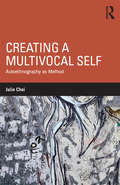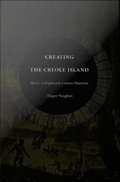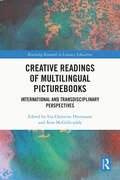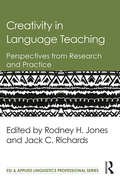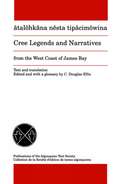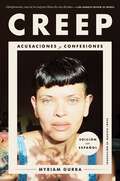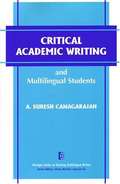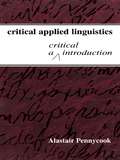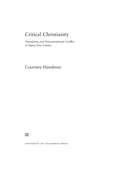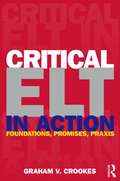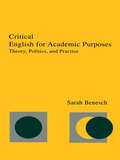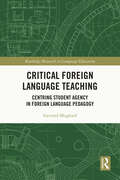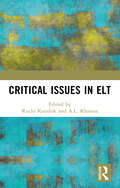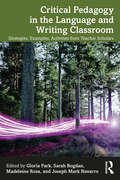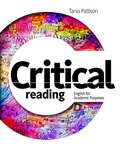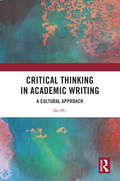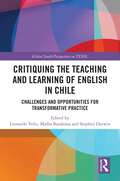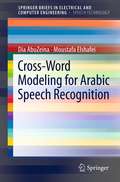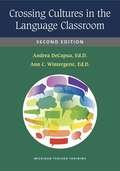- Table View
- List View
Creating a Multivocal Self: Autoethnography as Method
by Julie ChoiShowcasing a new methodology in language learning and identity research, this carefully conceptualized, innovative book explicates the use of autoethnography as a way of re-imagining one’s sense of linguistic and cultural identity. A key work for researchers and students in Applied Linguistics and Language Education, it addresses fundamental aspects of research methodology and explores substantive issues relating to individual dimensions of multilingualism. Choi shows convincingly how the learning of a language is inseparable from one’s constant searching for a voice, a place, and a self in this world, demonstrating the importance of interrogating what lies behind everyday life events and interactions—the political and ethical implications of the utterances, thoughts, actions, and stories of the self and others. Themes of authenticity, illegitimacy, power relations, perceptions of self/other, cultural discourses and practices, and related issues in multilingual identity development surface in the multi-modal narratives. Chapters on methodology, woven through the book, focus on the process of knowledge production, approaches to writing narratives, the messiness of research writing practices, and the inseparability of writing and research.
Creating the Creole Island: Slavery in Eighteenth-Century Mauritius
by Megan VaughanThe island of Mauritius lies in the middle of the Indian Ocean, about 550 miles east of Madagascar. Uninhabited until the arrival of colonists in the late sixteenth century, Mauritius was subsequently populated by many different peoples as successive waves of colonizers and slaves arrived at its shores. The French ruled the island from the early eighteenth century until the early nineteenth. Throughout the 1700s, ships brought men and women from France to build the colonial population and from Africa and India as slaves. In Creating the Creole Island, the distinguished historian Megan Vaughan traces the complex and contradictory social relations that developed on Mauritius under French colonial rule, paying particular attention to questions of subjectivity and agency. Combining archival research with an engaging literary style, Vaughan juxtaposes extensive analysis of court records with examinations of the logs of slave ships and of colonial correspondence and travel accounts. The result is a close reading of life on the island, power relations, colonialism, and the process of cultural creolization. Vaughan brings to light complexities of language, sexuality, and reproduction as well as the impact of the French Revolution. Illuminating a crucial period in the history of Mauritius, Creating the Creole Island is a major contribution to the historiography of slavery, colonialism, and creolization across the Indian Ocean.
Creative Readings of Multilingual Picturebooks: International and Transdisciplinary Perspectives (Routledge Research in Literacy Education)
by Áine McGillicuddy Esa Christine HartmannThis edited volume offers fresh perspectives on linguistic and cultural diversity in multilingual picturebooks, examining their potential to support multilingual learning in different educational contexts. Drawing on international, transdisciplinary perspectives from over fifteen countries, the book provides a comprehensive view of this unique literary genre.The collection showcases a wide range of languages featured in multilingual picturebooks, including Chinese, Farsi, Georgian, Irish, Korean, Malagasy, Mexican Indigenous languages, Mirandese, Northern Sámi, Portuguese, Spanish, Te Reo Māori, Ukrainian, and Welsh. Various chapters examine how multilingual picturebooks foster language and literacy development for emergent bilinguals in multilingual and multicultural environments, highlighting benefits such as linguistic and semiotic code-switching, as well as their ability to stimulate intercultural awareness in readers. The book also considers the creation, translation, and complex publishing processes of multilingual picturebooks, while exploring modern technologies such as eye tracking to analyse the reading processes of these books.Reflecting current insights and innovations in picturebook research, this volume will appeal to scholars, academics, and researchers in language and literacy education, multilingual education, and early childhood education. Those involved in children’s literature studies, multimodality, and bilingualism more broadly will also find this collection valuable.
Creativity in Language Teaching: Perspectives from Research and Practice (ESL & Applied Linguistics Professional Series)
by Jack C. Richards Rodney H. JonesCurrent, comprehensive, and authoritative, this text gives language teachers and researchers, both a set of conceptual tools with which to think and talk about creativity in language teaching and a wealth of practical advice about principles and practices that can be applied to making their lessons more creative. Providing an overview of the nature of creativity and its role in second language education, it brings together twenty prominent language teachers and researchers with expertise in different aspects of creativity and teaching contexts to present a range of theories on both creative processes and how these processes lead to creative practices in language teaching. Unique in the field, the book takes a broader and more critical look at the notion of creativity in language learning, exploring its linguistic, cognitive, sociocultural and pedagogic dimensions. Structured in four sections— theoretical perspectives, creativity in the classroom, creativity in the curriculum, and creativity in teacher development—each chapter is supplemented by Questions for Discussion and Suggestions for Further Research. Its accessible style makes the book relevant as both a course text and a resource for practicing teachers.
Cree Legends and Narratives from the West Coast of James Bay (Algonquian Text Society)
by John Carpenter Simeon Scott Xavier Sutherland Isaiah Sutherland John Wynne Joel Linklater Silas Wesley Hannah Wynne Gabriel Kiokee Andrew Faries Sophie Gunner James Gunner Willie Frenchman Hannah Loon Ellen McLeodThis is the first major body of annotated texts in James Bay Cree, and a unique documentation of Swampy and Moose Cree (Western James Bay) usage of the 1950s and 1960s. Conversations and interviews with 16 different speakers include: legends, reminiscences, historical narratives, stories and conversations, as well as descriptions of technology. The book includes a detailed pronunciation guide, notes on Cree terms, informants' comments, dialect variations, and descriptions of cultural values and customs. The introduction describes and compares the various genres in traditional and popular culture. Cree and English, with full glosssary.
Creep \ Creep (Spanish edition): Acusaciones y confesiones
by Myriam GurbaDe la aclamada autora de Mean (Mala onda), una de las escritoras que con más ferocidad han explorado la identidad latinx desde una perspectiva interseccional, llega esta implacable e incisiva colección de ensayos que confronta la opresión dominante e insidiosa, y la toxicidad que se ha colado en la sociedad: tanto en los libros, las escuelas y los hogares como en los sistemas que la perpetúan. Un creep puede ser una figura singular, un villano que obliga a las cosas a hacer ruido por la noche. Pero creep es también lo que hace la niebla: acecha para realizar su trabajo sucio, silenciar los gritos, ocultar la verdad y encubrir a aquellos que rondan en su interior. Creep es la sociología informal de Gurba sobre los creeps, una profunda exploración dentro de los oscuros recovecos de las tradiciones tóxicas que asolan a los Estados Unidos y dan vida a los agresores que invaden nuestros libros, escuelas y hogares. A través de una crítica cultural a modo de ensayos personales, Gurba explora las formas en las que la opresión se propaga colectivamente y sostiene ecosistemas que distribuyen de manera injusta el sufrimiento y la muerte prematura de los más vulnerables. Sin embargo, identificar individuos, grupos sociales y culturas creep es sólo la mitad del proyecto de este libro: la otra mitad consiste en examinar cómo nosotros, en tanto individuos, comunidades e instituciones, podemos desafiar los creeps y deshacer la niebla que pretende cegarnos.Con implacable agudeza, humor áspero y un estilo atrevido y despiadado, Gurba implica a todos y todo; desde Joan Didion hasta su antiguo agresor, desde los estereotipos mexicanos hasta el sistema carcelario, nadie saldrá indemne.---From talented Mexican American writer, story-teller, and visual artist Myriam Gurba comes a brand-new collection of essays that seek to redefine what a "creep" is, via cultural criticism disguised as personal essays and seek to redefine accountability, illuminating how social groups create, strengthen, perpetuate, and protect hierarchies which ensnare, harm, and sometimes even kill the subjugated.Myriam’s new book is an essay collection entitled CREEP (and Other Essays), which aims to be an informal sociology of creeps. Though the term may instantly evoke images of the Harvey Weinsteins of the world—and they are by no means outside of Myriam’s scope—these essays range far and wide to zero in on lesser-known and unexpected creeps like William Burroughs, Joan Didion, the criminal justice system, the public education system, and, yes, even our own publishing industry. Each essay a bullet, Myriam targets and identifies individual creeps, creepy social groups, and creepy cultures. But that’s only half of the book’s taxonomic project. The other half is examining how individuals, communities, and institutions challenge creeps and creepiness. The essays in CREEP—cultural criticism disguised as personal essay—seek to redefine accountability, illuminating how social groups create, strengthen, perpetuate, and protect hierarchies which ensnare, harm, and sometimes even kill the subjugated. The collection also maps oppression not as an act, but as an environment—the very water we’re swimming in, the air we breathe—that unfairly distributes suffering and premature death to those minoritized by gender, sexual orientation, race, ethnicity, immigration status, age, poverty, and other exploitable differences. Of course, Myriam does it all in the distinctive campy style for which she has become known, propelled by aggressive Chicana wit and an insatiable urge to tip sacred cows.
Creole Cultures, Vol. 2: Creole Identity and Language Representations
by Violet Cuffy Morgan Dalphinis Duane Edwards Michael M. KretzerThis edited book considers the significance of creole cultures within current, changing global contexts located within post-colonial and developing states. It also examines safeguarding the languages and cultural practices that sustain creole identities. The concept of Creolity as approached through the different lenses of postcolonial studies, history, and anthropology is used here to consider the social constructions of creole identities, their political and economic realities and how they are experienced as changing, particularly in the modern context. Themes explored are creole societies, folklore and orature, cultural hegemony, cultural sociology, hybridity, and national cultural Identity.
Creole Made Easy: A simple introduction to Haitian Creole for English speaking people
by Wally R. TurnbullThe most widely used introduction to Haitian Creole. A simple guide to Haitian Creole for English speaking people.The basic elements of Creole grammar and vocabulary in sixteen easy lessons. How to pronounce Creole words. Simple exercises with translation keys. Dictionary of 4,700 Creole English words.In less than an hour a day the short lessons will have you speaking basic Creole in about a week. You will learn key Creole words, how to pronounce those words, and how to put those words together into useful sentences.This book is ideal for those who will visit or work in Haiti and desire to communicate with her people.
Critical Academic Writing and Multilingual Students
by Canagarajah A. SureshThe critical approach to L2 writing is arguably one of the most significant recent developments in L2 writing pedagogy. A. Suresh Canagarajah provides a thorough discussion of this topic in Critical Academic Writing and Multilingual Students. This volume facilitates teacher self-reflection and enables readers to better understand the motivations and pedagogical implications--especially for L2 writing--of a more openly pedagogical approach. Critical Academic Writing and Multilingual Students explains what it means to commit to an academic pedagogy, in terms of form, self, content, and community--and what it can accomplish in the L2 writing classroom. It's a guide for writing teachers who wish to embark on a journey toward increased critical awareness of the role they play, or potentially could play, in the lives of their students.
Critical Applied Linguistics: A Critical Introduction
by Alastair PennycookThis accessible guide and introduction to critical applied linguistics provides a clear overview, highlighting problems, debates, and competing views in language education, literacy, discourse analysis, language in the workplace, translation and other language-related domains. Covering both critical theory and domains of practice, the book is organized around five themes: the politics of knowledge, the politics of language, the politics of texts, the politics of pedagogy, and the politics of difference. It is an important text for anyone involved in applied linguistics, TESOL, language education, or other language-related fields.
Critical Applied Linguistics: A Critical Re-Introduction
by Alastair PennycookNow in its second edition, this accessible guide and introduction to critical applied linguistics provides a clear overview of the problems, debates, and competing views in language education, literacy, discourse analysis, language in the workplace, translation, and other language-related domains. Covering both critical theory and domains of practice, the book is organized around five themes: the politics of knowledge, the politics of language, the politics of difference, the politics of texts, and the politics of pedagogy. Recognizing that a changing world requires new ways of thinking, and that many approaches have watered down over time, the new edition applies a sharp, fresh look at established and new intellectual frameworks. The second edition is comprehensively updated with additional research throughout and features new discussions of colonialism, queer theory, race and gender, translanguaging, and posthumanism. With a critical focus on the role of applied linguists, Pennycook emphasizes the importance of a situated, collaborative perspective that takes the discussion away from questions of implementation, and insists instead that critical applied linguistics has to be an emergent program from the contexts in which it works. This landmark text is essential reading for students and researchers of applied linguistics, multilingualism, language and education, TESOL, and language and identity.
Critical Christianity: Translation and Denominational Conflict in Papua New Guinea
by Courtney HandmanIn Critical Christianity, Courtney Handman analyzes the complex and conflicting forms of sociality that Guhu-Samane Christians of rural Papua New Guinea privilege and celebrate as "the body of Christ. ” Within Guhu-Samane churches, processes of denominational schism-long relegated to the secular study of politics or identity-are moments of critique through which Christians constitute themselves and their social worlds. Far from being a practice of individualism, Protestantism offers local people ways to make social groups sacred units of critique. Bible translation, produced by members of the Summer Institute of Linguistics, is a crucial resource for these critical projects of religious formation. From early interaction with German Lutheran missionaries to engagements with the Summer Institute of Linguistics to the contemporary moment of conflict, Handman presents some of the many models of Christian sociality that are debated among Guhu-Samane Christians. Central to the study are Handman's rich analyses of the media through which this critical Christian sociality is practiced, including language, sound, bodily movement, and everyday objects. This original and thought-provoking book is essential reading for students and scholars of anthropology and religious studies.
Critical Disciplinary Literacy: An Equity-Driven and Culturally Responsive Approach to Disciplinary Learning and Teaching
by Jacy Ippolito Christina L. Dobbs Megin Charner-Laird Christine Montecillo LeiderThis accessible book introduces a new theory of critical disciplinary literacy (CDL) that merges criticality and disciplinary literacy approaches in a cohesive and inclusive framework. There are unique hurdles in integrating critical and culturally sustaining approaches to literacy into specialized content area classrooms, but this book provides clear, research-grounded strategies and methods that will appeal to teachers and help them foster equitable literacy learning opportunities for all students. Using a critical lens, chapters deconstruct and reconstruct pathways for new practices that push back on familiar, normative literacy approaches in the disciplines. Authors provide a framework for designing new approaches to disciplinary literacy both for and with students, and they present innovative and practical strategies for implementation. With real-world examples from the field, this book will be essential reading for preservice teachers and in courses on literacy and disciplinary instruction.With vignettes and classroom examples from educators who have been enacting elements of CDL practices for years, this book will be essential reading for preservice educators in courses on both literacy and content instruction. Furthermore, current and seasoned educators and educational leaders will find this book to be an invaluable resource as they wrestle with how to teach disciplinary literacy in ways that move away from approaches that have historically marginalized many voices to approaches that include and center students’ languages, histories, and cultures.
Critical Discourse Analysis in Translation Studies: An Introductory Textbook
by Kyung Hye KimCritical Discourse Analysis in Translation Studies is the first textbook to provide a systematic treatment of how CDA may be applied to the analysis of translated and interpreted texts.Kyung Hye Kim provides in-depth explanations about how various strands of CDA, from the M.A.K. Hallidayan analytical framework to Norman Fairclough’s dialectical relationship model and Teu van Dijk’s ideological square, can be employed in translation studies to deliver rich analyses of translated text. She demonstrates the ability of CDA to address complex translation practices, in both traditional and digital media, using various examples in different languages. With numerous exercises using authentic texts, this textbook empowers readers to apply a CDA framework in their own work.This accessible textbook is essential reading for all students of discourse and text analysis within translation and interpreting studies.
Critical ELT in Action: Foundations, Promises, Praxis
by Graham V. CrookesUniquely bridging theory and practice, this text introduces and overviews the various domains associated with the term critical pedagogy in the field of TESOL/ELT. Critical pedagogy addresses concepts, values, curriculum, instructional and associated practices involved in language teaching for social justice. Bringing critical pedagogy to classroom practitioners in a practical and comprehensible way, the text is designed to help teachers get started on critically grounded work in their own teaching. Features• Textbook extracts offer direct and quick illustration of what this perspective might look like in practice• Coverage of feminist and anti-racist pedagogies; sexual identity, oppression and pedagogy; peace and environmental education; and critical English as a foreign language—and their implications for second-language teaching • Historical background• Theoretical background on language and learning• Consideration of applicability of critical/radical educational concepts and traditions to non-Western cultural contexts • A focus on issues of compromise and resistance This original, timely, and informative text is ideal for any course on methods and approaches in TESOL.
Critical English for Academic Purposes: Theory, Politics, and Practice
by Sarah BeneschCritical English for Academic Purposes: Theory, Politics, and Practice is the first book to combine the theory and practice of two fields: English for academic purposes and critical pedagogy. English for academic purposes (EAP) grounds English language teaching in the cognitive and linguistic demands of academic situations, tailoring instruction to specific rather than general purposes. Critical pedagogy acknowledges students' and teachers' subject-positions, that is, their class, race, gender, and ethnicity, and encourages them to question the status quo. Critical English for academic purposes engages students in the types of activities they are asked to carry out in academic classes while inviting them to question and, in some cases, transform those activities, as well as the conditions from which they arose. It takes into account the real challenges non-native speakers of English face in their discipline-specific classes while viewing students as active participants who can help shape academic goals and assignments. Critical English for Academic Purposes: Theory, Politics, and Practice: * relates English for academic purposes and critical pedagogy, revealing and problematizing the assumptions of both fields, * provides theoretical and practical responses to academic syllabi and other institutional demands to show that teachers can both meet target demands and take students' subjectivities into account in a climate of negotiation and possibility, * offers "rights analysis" as a critical counterpart to needs analysis, * discusses the politics of "coverage" in lecture classes and proposes alternatives, and * features teaching examples that address balancing the curriculum for gender; building community in an EAP class of students from diverse economic and social backgrounds; students' rights; and organizing students to change unfavorable conditions. This book is intended for undergraduate and graduate courses for preservice and in-service ESL and EAP teachers. It is also a professional book for those interested in critical approaches to teaching and EAP.
Critical Foreign Language Teaching: Centring Student Agency in Foreign Language Pedagogy (Routledge Research in Language Education)
by Gerrard MugfordThis book develops the theory and practice of critical foreign language pedagogy. Written by a distinguished scholar of pragmatics and sociolinguistics, it encourages educators to think beyond traditional methods of language teaching to consider both the social reality of being a foreign language user and the personal goals and experiences of each learner. It emphasises the need to teach students how to navigate the types of interactional difficulties, power imbalances, and hostility they may experience outside of the classroom as well as how to recognise and analyse ‘native’ speaker norms and practices. It further stresses the importance of first-language knowledge in developing foreign language expertise, encouraging educators to build on the skills learners already have to empower them to express their personality and individuality in their target language.A significant contribution to foreign language pedagogy, this book offers language teachers, bilingual speakers, and researchers practicable insights into how to support learners to attain and realise their own goals and aspirations in their target language.
Critical Issues in ELT
by Ruchi Kaushik A. L. KhannaELT, a vast and growing field of research, has now moved beyond primary concerns related to developing learners’ proficiency in the language and designing curricula, syllabi, materials and assessment tools. It is witnessing rapid development towards de-centralizing and de-elitizing English, promoting multilingual approaches for teaching English and bridging the gap between language-in-education policies and practices.Critical Issues in ELT compiles research papers by linguists, language teachers, and English language teaching professionals to present contemporary debates on critical issues related to English language teaching, primarily in India. The subject matter of this book includes a variety of articles based on empirical data. It discusses the challenges facing ELT today and also includes papers discussing theoretical positions/frameworks/issues in ELT, classroom-based action research projects, and personal narratives.Print edition not for sale in South Asia (India, Sri Lanka, Nepal, Bangladesh, Pakistan or Bhutan)
Critical Literacy with Adolescent English Language Learners: Exploring Policy and Practice in Global Contexts (Routledge Research in Language Education)
by Jennifer AlfordThis book examines critical literacy within language and literacy learning, with a particular focus on English as an Additional Language learners in schools who traditionally are not given the same exposure to critical literacy as native-English speakers. An important and innovative addition to extant literature, this book explains how English language teachers understand critical literacy and enact it in classrooms with adolescent English language learners from highly diverse language backgrounds. This book brings together the study of two intersecting phenomena: how critical literacy is constructed in English language education policy for adolescent English language learners internationally and how critical literacy is understood and enacted by teachers amid the so-called ‘literacy crisis’ in neoliberal eduscapes. The work traces the ways critical literacy has been represented in English language education policy for adolescents in five contexts: Australia, England, Sweden, Canada and the United States. Drawing on case study research, it provides a comparative analysis of how policy in these countries constructs critical literacy, and how this then positions critical engagement as a focus for teachers of English language learners. Empirically based and accessibly written, this timely book will be of interest to a wide range of academics in the fields of adolescent literacy education, English language learning and teaching, education policy analysis, and critical discourse studies. It will also appeal to teachers, post-graduate students and language education policy makers.
Critical Pedagogy in the Language and Writing Classroom: Strategies, Examples, Activities from Teacher Scholars
by Gloria Park Sarah Bogdan Madeleine Rosa Joseph Mark NavarroThis volume introduces theory-to-practice-based critical pedagogy grounded in Paulo Freire’s scholarship to language and literacy learning settings. The chapters present authentic experiences of teacher-scholars, feature real-world examples and activities ready for implementation in the classroom, and provide nuanced guidance for future teachers. The examples and activities from teacher-scholars place critical pedagogy at the heart of classroom contexts and cover key topics, including place-based pedagogy, contemplative pedagogy, technology within the classroom, and translingual and multimodal paradigms. The chapters include further readings and discussion questions that challenge assumptions and promote deeper reflection, and can be modified for different teaching contexts. This practical volume is essential reading for students and scholars in TESOL and critical pedagogy.
Critical Reading: English for Academic Purposes
by Tania PattisonCritical Reading provides a systematic introduction to the process of analyzing and evaluating a written text. Students develop critical reading skills through analysis of texts from authentic sources (journals, newspapers, magazines, and websites) and a variety of academic dsiciplines. They are encouraged to develop their comprehension and vocabulary skills, while forming a reasoned assessment of the effectiveness and validity of a text.
Critical Thinking in Academic Writing: A Cultural Approach
by Shi PuThe book inquires into critical thinking through a cultural approach. Based on an 8-month ethnographic study, it compares Chinese postgraduate students’ conceptualisations and applications of critical thinking in three different settings in China and the UK. From an insider’s perspective, it analyses the intricate interplay of multiple cultural and individual factors that conditions students’ critical thinking development as they learn to write an academic thesis and to manage postgraduate learning. The book offers insights into the nature of problems that Chinese students encounter with critical thinking and envisions possibilities for the ideas for critical thinking to have a transformative power in an intercultural space. The book will primarily be of interest to academics and educators who work on critical thinking and academic writing, especially those who work with Chinese students. Scholars interested in intercultural issues in higher education may also find it relevant.
Critiquing the Teaching and Learning of English in Chile: Challenges and Opportunities for Transformative Practice (Global South Perspectives on TESOL)
by Stephen Darwin Darío Luis Banegas Malba Barahona Leonardo Veliz Loreto Abarzúa Silva Rommy Anabalón Schaaf María Cristina Arancibia Natalia Asenjo Roxana Balbontín-Alvarado Corinne Barger Víctor Birkner Diego Cabezas Bravo Tatiana Cárcamo Rojas Tamara Cortés Seitz Martha Epperson Eric Gómez Burgos Alexia Guerra Rivera Pamela Lara-Morales Paulina Moya-Santiagos Carolina Muñoz Muñoz, Belén Alicia Páez Nykoll Pinilla-Portiño Camilo Ramos-Gálvez Priscila Riffo-Salgado Margarita Ulloa Toro, María Yasna Yilorm BarrientosThis edited volume challenges the hegemonic values and practices that have shaped the contemporary state of English language education in Chile, offering a space for a transformative vision that prioritises pedagogical practices grounded in (g)localised methodologies and epistemologies.Providing insights into English language teacher education and the pedagogical practices that teachers enact in diverse contexts, chapters delve into a critical scrutiny of prevalent issues in ELT education and explore new opportunities for innovation, reconsideration and reconceptualisation of policy and practice. Motivated by the drive for transformative, context-sensitive and culturally relevant practice, contributors critically engage with the socio-cultural and socio-political context of Chilean English language researchers, offering a systematic analysis of the profound effects of entrenched neoliberal ideologies in education, as well as how these act to influence and shape teaching practices, policies, and outcomes. In highlighting the inherent limitations and inequities perpetuated by neoliberal policies, contributors offer alternative perspectives and solutions designed to promote more equitable, inclusive, and socially just second language educational practices.Providing a comprehensive examination of the intricate relationship between Chile's political history, socio-economic evolution, and the rise of English language education, this book will be of interest to scholars, researchers, and postgraduate students in the fields of applied linguistics, teaching and learning English as a foreign/second language, and initial English language teacher education. Policy makers working in ELT in the Chilean context may also find the volume of use.
Cross-Word Modeling for Arabic Speech Recognition (SpringerBriefs in Speech Technology)
by Dia Abuzeina Moustafa ElshafeiCross-Word Modeling for Arabic Speech Recognition utilizes phonological rules in order to model the cross-word problem, a merging of adjacent words in speech caused by continuous speech, to enhance the performance of continuous speech recognition systems. The author aims to provide an understanding of the cross-word problem and how it can be avoided, specifically focusing on Arabic phonology using an HHM-based classifier.
Crossing Cultures In The Language Classroom, Second Edition
by Andrea DeCapua Ann WintergerstCrossing Cultures in the Language Classroom attempts to balance theory and practice for pre-service and in-service teachers in general education programs or in ESL/EFL, bilingual, and foreign language teacher training programs, as well as cross-cultural awareness workshops. This book is unique in that it combines theory with a wide range of experiential activities and projects designed to actively engage users in the process of understanding different aspects of cross-cultural awareness. The goals of the book are to help readers: expand cultural awareness of one’s own culture and that of others achieve a deeper understanding of what culture is and the relationship between culture and language acquire the ability to observe behaviors in order to draw conclusions based on observation rather than preconceptions understand and implement observations of cultural similarities and differences develop an attitude of tolerance toward cultural differences and move away from the “single story.” The new edition has been thoroughly updated and includes a Suggested Projects section in each chapter. This section provides opportunities for users of the text to explore in greater depth an area and topic of interest. It also includes even more Critical Incidents--brief descriptions of events that depict some element or elements of cultural differences, miscommunication, or culture clash. Critical Incidents develop users’ ability to analyze and understand how multiple perspectives of the same situation are rooted in differing culturally influenced beliefs, behaviors, norms of interaction, and worldviews.
